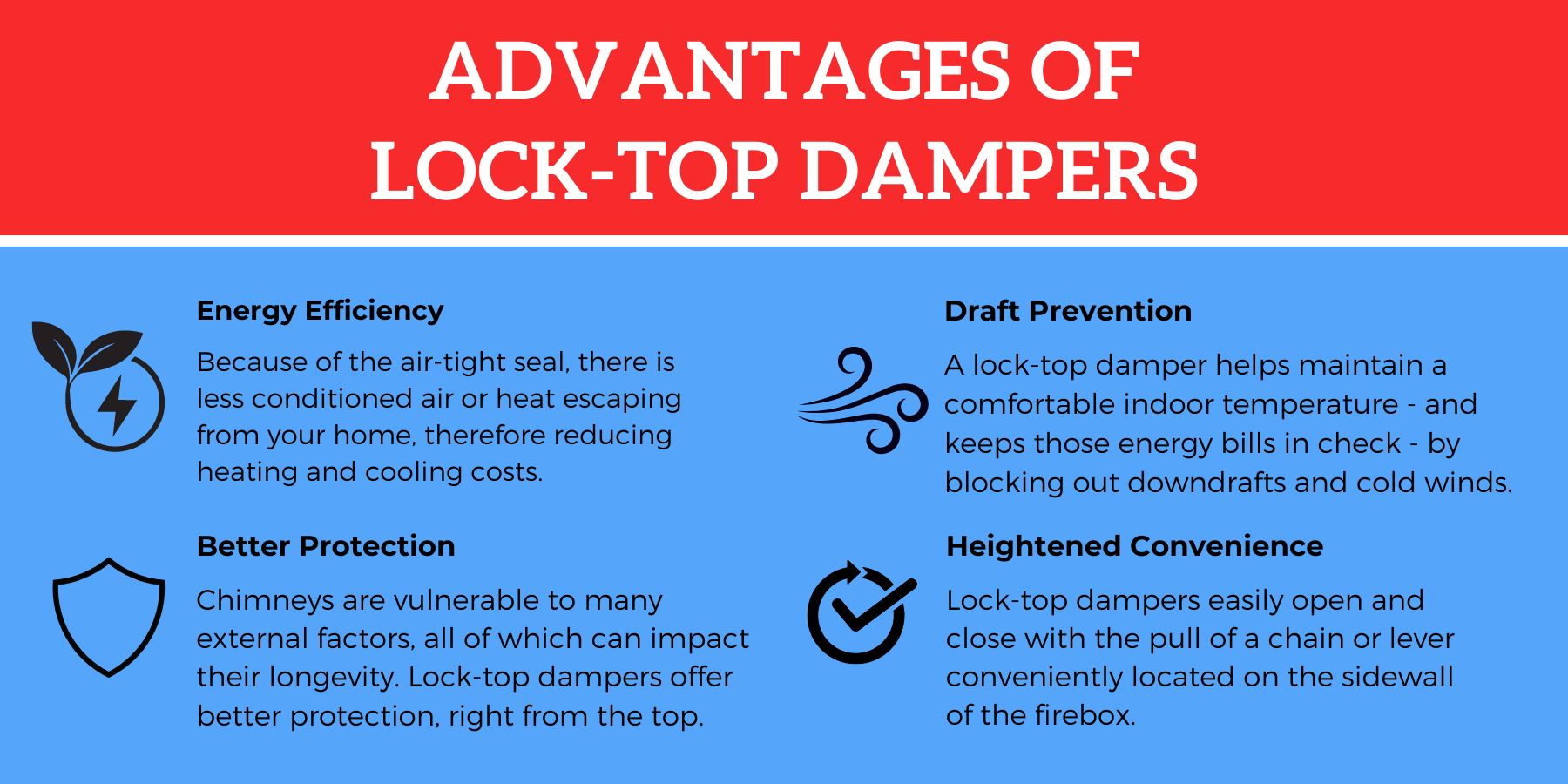There’s no question that a chimney has many working components. Each part serves an important role in the overall efficiency and functionality of your fireplace. One crucial component, that is often overlooked, is the chimney damper.
What does a chimney damper do? A damper regulates airflow and prevents heat loss when the fireplace is not in use. And while traditional throat dampers have been a go-to choice for years, lock-top dampers have gained popularity over the years, as homeowners discover their many advantages.
Interested in learning more or need to book an appointment? Reach out today – we’re here for you.
How Does a Lock-Top Chimney Damper Work?
A lock-top chimney damper is a lot like a lid on the top of your chimney exhaust vent that, with the help of a steel cable controlled by you, either lifts up to let out smoke and fumes or completely seals the chimney opening when the fireplace is not in use.
With help from the silicone rubber gasket around the edge, a lock-top damper guarantees an air-tight seal. And because of the location of the damper being at the very top of the chimney, it essentially serves two purposes: that of a damper, and that of a vent cover.
- When the damper is open, it allows smoke and gases to exit the chimney, while preventing drafts from entering.
- When the fireplace or stove is not in use, the damper can be closed to seal off the chimney, preventing heat loss and blocking entry of outside air, pests, and debris.
What Are the Advantages of Using a Lock-Top Damper?
Why should you consider a lock-top damper over a traditional throat damper? Here’s a few reasons we can think of:

- Enhanced Energy Efficiency: Because of the air-tight seal that a lock-top damper creates, there is less conditioned air or heat escaping from your home. This improves energy efficiency by reducing heating and cooling costs.
- Improved Draft Prevention & Insulation: Have you ever noticed how drafty your fireplace is when not in use? Not a very cozy place to sit, in our humble opinion. A lock-top damper helps maintain a comfortable indoor temperature by blocking the outside elements.
- Ultimate Protection: Because chimney exhaust vents sit at the very top of the chimney, this makes them vulnerable to many external factors like extreme weather, animals, and falling debris – all of which can impact their functionality and longevity.
- Longer Lifespan: Lock-top dampers are made from durable materials, like stainless steel, which is resistant to rust. In comparison to a cast iron throat damper (that can deteriorate quickly because of its exposure to heat, moisture, and corrosive byproducts), a lock-top damper will last longer – and often comes with a lifetime warranty.
- Convenience: With some throat dampers, you nearly have to stick your entire head up the fireplace to open and close them. However, with a lock-top damper, you can easily open and close with the pull of a chain or lever conveniently located on the sidewall of the firebox.
Can a Lock-Top Damper Be Used With Different Types of Fuel Sources?
Although lock-top dampers are very versatile in being able to fit just about any flue, it is really only made to be used with open wood-burning masonry fireplace chimneys.
A lock-top damper is not intended to be installed in the following:
- Vented Gas Logs: This type of fireplace requires the damper to be removed completely or permanently fixed to an open position. That is to ensure that soot, fumes, and carbon monoxide do not enter your home.
- Vent-Free Gas Logs: The moisture generated from the gas logs could damage the chimney, so it is recommended that you get approval from the appliance manufacturer first.
- Other Fuel Types: Lock-top dampers are not intended to be used on chimneys serving other fuels or other appliances like gas inserts, furnaces, etc.
Can I Install a Lock-Top Damper on an Existing Chimney?
Lock-top dampers can be installed on an existing chimney vent flue, yes…as long as it doesn’t meet any requirements mentioned on the previous list. However, the more important part of that question to address is whether or not you should install it yourself.
It is always strongly recommended that you use the services of a qualified chimney technician. The main reason for this is for safety reasons, as certified chimney technicians come equipped with all of the necessary safety equipment and tools to perform the job with as minimal risks as possible. In addition, only a professional can determine if your chimney is suitable for a lock-top damper, as well as ensure it is installed and functioning correctly.
And one final note: Most lock-top damper manufacturers only warranty the damper if installed by a professional chimney technician.
We’re Here To Help
Speaking of professionals, we know a few at Highpoint Chimney Services. Our certified chimney technicians would be happy to not only help with your adding a lock-top damper, but address any and all of your chimney and fireplace concerns. So give us a call at 908-864-4114 or schedule your appointment on our website. We’d love to hear from you!

Recent Comments